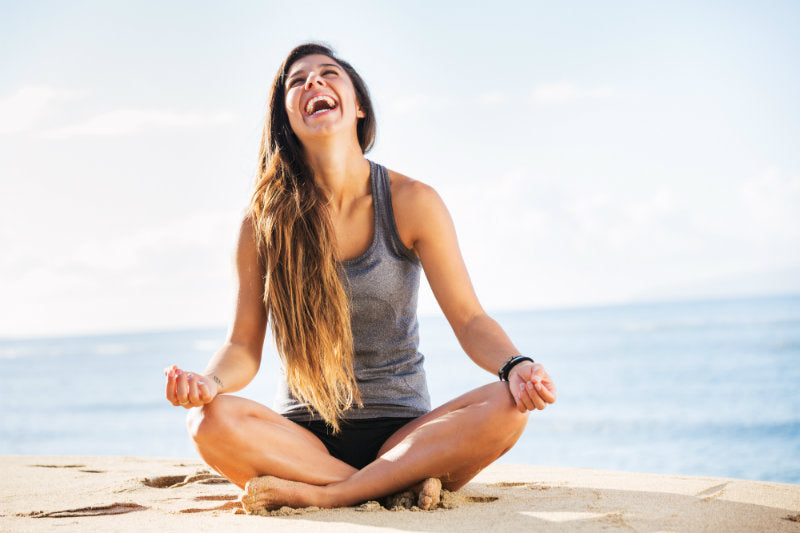As social media and the concept of “wellness” has grown to permeate every aspect of modern life, you may have encountered many wellness figures (doctors, therapists, professors and “influencers” alike) preaching about the benefits of meditation.
Though it is a practice that has been explored for thousands of years by many cultures, meditation is not often taught in families, schools or workplaces in the Western world. But as official studies of the practice have grown in frequency and scale over the decades, the medical and wellness worlds are steadily acknowledging the myriad of clear physical, mental and spiritual benefits (1) that Buddhism has touted for thousands of years.
What is meditation?
Meditation is described as stillness of the mind, a state of relaxation or peace and contentment; (2) an awareness of simply ‘being’ rather than thinking or feeling.
The practice of mediation can look and feel different for everyone – but the main objective is to quiet the mind and detach from your thoughts: to become the ‘observer’ and allow them to simply pass by. For many, the concept of meditation is daunting, confusing or sounds downright impossible - how can you just turn off that inner monologue that runs through your mind almost every second of your waking day?
Like any skill, mediation takes practice. For most of us, stepping back from our internal monologue is a foreign concept and doesn’t come all that naturally. But through regular practice of mindfulness and meditation techniques, a meditative state will become easier and easier to achieve.
Learning to meditate is a simple process that will begin to cause noticeable and positive ‘side affects’ on many aspects of your life. Eventually you will become more able to return to the present moment by grounding yourself in the here and now without judgement, which can invoke a deep sense of peace and contentment. In short, meditation improves our relationship with ourselves, and by extension, with those around us.

How can meditation benefit me?
Meditation is known to have many positive physical, mental, emotional and spiritual benefits. These can include things like having a healthier heart and stronger immune system due to less stress held in the body, and even feeling more love and compassion towards others (3).
Perhaps the most powerful day-to-day side effects that regular practice of meditation is capable of fostering are:
Reduces Stress
Stress has become so commonplace in our fast-paced, modern lives that we often learn to live with it without acknowledging the damage it can do to our health. When you’re in a constant state of stress, it can easily be forgotten that it could be the root cause of issues like high blood pressure, irritable bowel syndrome or fatigue (4).
Being able to emotionally detach from the demands of every-day life as well as intense or stressful situations is an invaluable skill. Meditation has consistently shown to be an effective stress management tool by teaching meditators to recognise mental patterns and, therefore, be less affected by them (5).
Minimises Anxiety
Like the side effects of stress, anxiety and worry can be managed with meditation. Anxious thoughts can creep into your head and take over before you have become aware of it. Through becoming mindful of the inner dialogue that is dictating your day, you can more easily step back from anxious thoughts and acknowledge them for what they are: just thoughts.
Promotes Emotional Wellbeing
Though one of the goals of meditation is to become less controlled by your emotions, this doesn’t mean you shouldn’t feel them; in fact, it’s quite the opposite. Meditation allows and encourages you to feel all emotions as they arise. You may find that during practice, when your mind is quiet, many feelings come up. Allowing yourself to feel them fully, acknowledge them, and then letting them pass is all part of the process.
In fact, many people who practice meditation long term have been found to experience less depression and have a more positive outlook on life (3).
Supports Good Sleep
Do you ever find your thoughts keep you awake late into the night, worried or excited about the next day? Meditation is a useful tool to calm the mind before bed, making sleep easier and more natural to fall into.
Furthermore, the physical benefits associated with meditation – less tension in the body, lower heart rate and a more relaxed state – can keep you asleep for longer as well as improve the quality of sleep.
Different Strokes for Different Folks
Meditation doesn’t have to involve sitting in a lotus position and chanting ooohhhmmmm for hours on end. There are many ways to get into a clear and meditative headspace, and each person’s ideal practice can look different. Try a few of these techniques and begin to build daily habits around what feels good for you.
Visualisation
Imagine yourself in a calm, peaceful place. This could be something like walking through a forest, sitting on a beach or laying under the stars. Take the time to notice the little details in your surroundings and see your surroundings instead of trying to make sense of them.
Guided Audio
There are thousands of free guided meditations you can listen to online, with many for different purposes such as reducing stress, building confidence or letting go. These will generally involve someone speaking gently to you and guiding you through some breathing exercises and visualisations.
Breathing Techniques
Your breath is the one thing you will have with you at all times, no matter where you are. Breathing slowly and deeply can have a profound effect on your physical and mental state, helping to calm you down as you pull more oxygen into the body. In meditation, returning to the breath each time your mind strays is commonly used as a helpful anchor.
There are many patterns of breathing you can experiment with to help you guide you into a relaxed state. For example, the 4-7-8 technique, also known as the “relaxing breath technique” involves breathing in for 4 seconds, holding the breath for 7 seconds, and exhaling for 8 seconds.
Body Scan
The body scan technique is a simple exercise used to bring you into your body and away from your thoughts. It involves paying close attention to each individual part of your body, moving upwards (or downwards) from head to toe, feeling the body part and making any adjustments to relax it completely. By the time you’ve reached your head, you will be almost asleep!
Entering a Flow State
Any part of your day where you are not thinking, but simply doing or being, could be considered meditation. Have you ever wondered why it feels so good to lose track of time while playing an instrument, creating art, or practising yoga? This is because you are in a flow state – a state of being where you are no longer thinking but simply being in the present moment, consumed by the enjoyment of the activity.
Benefits of tapping into a flow state include feelings of euphoria, enhanced concentration, a sense of clarity and long-lasting feelings of happiness and fulfilment (6).

How to Practice
The idea of starting something new can often be daunting, but beginning a meditation practice can look as simple as setting aside five minutes of your day to devote to yourself. Find a quiet space, sit or lay down in a comfortable position, and take a deep breath. Begin to quiet the mind. If you notice that your thoughts have strayed, don’t fret – simply acknowledge the thought and then return to your breath.
Once you are comfortable, you can start to build up the time of your sessions until you are spending as much time meditating as you feel is beneficial to you. The most important thing is to be consistent – setting aside time and intention to do something every day will build habits that stick with you for many years to come and ensure you reap the most benefits.
Remember: don’t put any pressure on yourself to achieve anything with your meditation practice. It is often said that there is no goal to meditation itself; it is simply a tool used to help you in other aspects of your life.
Additional Things to Consider
It won’t be long before you start to notice the ways in which the benefits of consistent meditation creep into many aspects of your life. There are a few ways of thinking that may naturally come as a happy side-effect of meditation, or you may find as beneficial to be investigated in tandem with your new practice. Try exploring these concepts alongside meditation to feel a noticeable shift in the way you think, feel and perceive the world around you.
Mindfulness
Mindfulness is the concept of going about your day with a sense of intention: taking the time to notice the little things, giving your undivided attention to whatever you are doing, and letting reactive thoughts and feelings pass by without dictating your actions. Mindfulness is not a state of mind like we experience in a meditative state, but rather a way of living that allows us to step back and look at the bigger picture.
Gratitude
Taking the time to really acknowledge the things in your life that you are grateful for has the power to truly shift your mindset and perspective from one of lack to one of abundance. A simple way to start incorporating this into your day-to-day could be writing down three things you are looking forward to, saying aloud what you were grateful for today, or even using a task as mundane as brushing your teeth as time to think about the things that bring joy to your life.
Before long, you will be looking for these moments, and learn to appreciate them as they happen. As you enter each day with this mindset, suddenly even your most boring day will become one filled with opportunity and magic.
Presence
Like mindfulness, presence involves becoming more aware of your surroundings and the little things that make up your day. It takes you out of your mind and into your body, allowing you to worry less and enjoy more as you simply take in the moment around you instead of trying to make sense of everything in your head. This may become easier as your meditation practice progresses.
Conclusion
Meditation is one of the simplest and easy ways to change your life. It isn’t about becoming a new person or even a better person - it is simply about training your brain to move away from worry, judgement and intrusive thoughts. Instead, it promotes a mindset that fosters happiness, fulfilment, contentment and peace. So go on, give it a try – you have everything to gain.
References
- Chu, L. 2009, The benefits of meditation vis-a-vis emotional intelligence, perceived stress and negative mental health, Stress & Health Journal.
- Marlatt, G. A., & Kristeller, J., 1999, Mindfulness and meditation. In W. R. Miller (Ed.), Integrating spirituality into treatment: Resources for practitioners (p. 67–84). American Psychological Association.
- Kristeller, J. & Johnson, T., 2005, Cultivating loving kindness: a two-stage model of the effects of mediation on empathy, compassion and altruism, Journal of Science and Religion, Zygon.
- Dhabhar, F.S., 2014, Effects of stress on immune function: the good, the bad, and the beautiful, Immunol Res.
- https://www.headspace.com/meditation/meditation-for-beginners
- https://www.headspace.com/articles/flow-state


